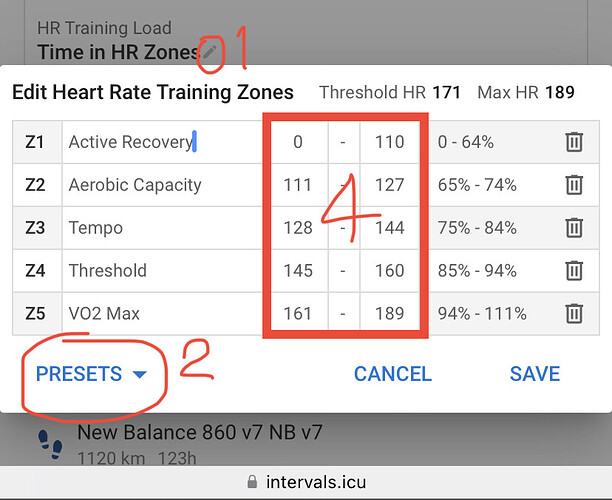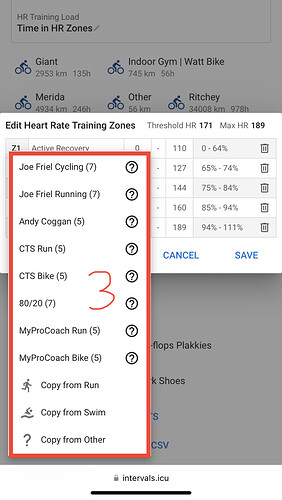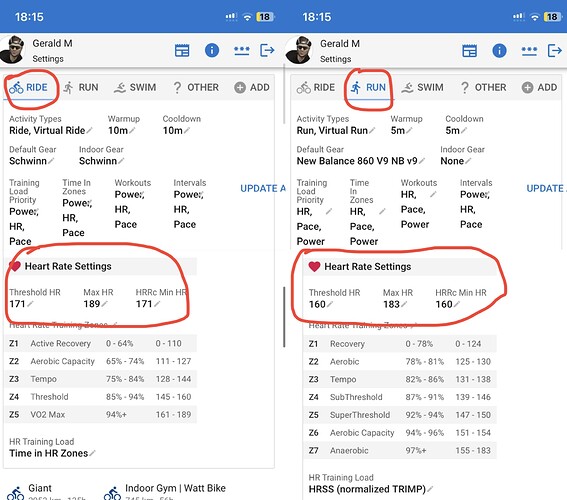I’m pretty new to the whole “training” thing, having previously ridden for fun and not really cared about the numbers. However, age catches up with us all and I’m now paying more attention in order to maximise my abilities and time. I have a question, the answer to which I can’t quite seem to find on the forum and I’m looking for a simple answer (which may not be possible).
I run and ride with Garmin devices, also using Zwift as indoor cycling when the weather is rubbish. I’m becoming aware of the recommendation to carry out most training in HR Zone 2 and have set those on Garmin according to my regularly recorded Max HR and letting Garmin work it out. However, I see that Intervals breaks it into 7 zones and I’d ideally like to know which Zone 2 I should be working at and, if it’s the Intervals Z2, how I should configure my Garmin devices so that I can monitor my activities in progress.
Thanks
You can customise your HR zones in settings:
In step 4, you can customise the zones to suit you own levels, but you can’t have overlapping numbers, eg. one level ends at 127 and the next starts at 128.
In terms of zone 2, there’s a lot of grey area. The more (volume) you do, the more zone 2 you should be doing. If you’re a time-crunched athlete, you have lots of time to rest, so need to spend a bit more time above the traditional zone 2.
Rather, note the point where your breathing changes from only in/out the nose (gear 1) to in the nose and out the mouth. That will be the top of zone 1 (recovery). Where your breathing changes from in nose and out the mouth (gear 2) to mostly in/out the mouth will be the top of zone 2 up to the mid point of zone 3; it’s a noticeable change. Keep all your easy workouts below this level.
Above this point, is where things become a bit taxing, and you feel you need to back off after a certain time. The harder you go above this level, the less time you can spend at the level. It’s not the all out effort type workouts, but rather the sweet spot to upper threshold (zone 3.5 to upper end of level 4.
The all out efforts are exactly that, all out (VO2max, 2-6 min efforts) where you are pushing at your max level of oxygen intake.
Edit:
Should be mostly in/out the mouth.
2 Likes
I’m struggling to get the gist here.
I get I should look out for breathing. I’m looking for changes
from only in/out the nose (gear 1) to in the nose and out the mouth. That will be the top of zone 1 (recovery)…
from in nose and out the mouth (gear 2) to mostly out the mouth will vbe the top of zone 2 up to the mid point of zone 3;
As both are in the nose and out the mouth (or mostly out the mouth for Z2-mid3) the difference is gear 1 and gear 2. So which gears are these please?
Gears 1-3 are three “stages” of breathing, namely:
- Nose only breathing
- In nose, out mouth;
- Mostly in/out the mouth.
A number of factors affects breathing, eg. cadence, so make note of that too.
Check where your heart rate is when your breathing changes. Over time you will get use to it, and will know when you’re going harder than you need to.
Ah that’s very helpful thank you.
I still don’t understand your original descriptions though.
You advise
from only in/out the nose (gear 1) to in the nose and out the mouth. That will be the top of zone 1 (recovery)…
OK I’m fine the top of Z1 and ergo bottom of Z2 is the switch to mouth out
You then advise
from in nose and out the mouth (gear 2) to mostly out the mouth will be the top of zone 2 up to the mid point of zone 3;
Damn I’m being thick. From mouth out bottom Z2 to mostly mouth out takes us to top of Z2 and on to mid Z3. Is it mostly mouth in and out that’s top of Z2 to mid Z3 please?
I’m a nice but dim bloke and this stuff takes me time to work out.
Thanks for all your help.
Noone ever said this was easy 
There’s some solid advice in @Gerald 's posts here!
1 Like
Gear 1/Zone 1 (Recovery)
You can breathe through your nose.
It feels easy, and you can talk completely normally.
Gear 2/Zone 2 (Endurance) and lower half of Tempo (zone 3)
You can breathe though the nose and out the mouth. You can hold a normal conversation without pausing for a breath.
————————
This is the point where you should cap workouts to being easy. Going over this point, and you’re above the area known as zone 2.
————————
Gear 3/Upper half of zone 3 (Tempo) and higher (Threshold)
You breathe in and out through your mouth
You start panting, can’t hold a conversation without trying to pause for a breath.
It’s two distinct changes in your breathing, making for 3 levels/zones. After Gear 3, breathing is out of control; conversation is limited to a word here and there.
Hope this explains it easier.
3 Likes
It’s perfect thank you, how I experience it and how I work with it.
It helps perfectly reading between Garmin 5 and TP 7 zone models where the two most discernible differences occur for me based on my 5 and 7 zone range numbers at
a) >mid Z3 Garmin which is shown separately in TP as sub threshold Z4, and then much later
b) with the inclusion of anaerobic capacity separately in TP to the Garmin Z5 in which it is included
Thank you again.
Very much appreciated
Thanks for the responses. My query was initially set off by the fact that I was using the default Garmin zones (based on Max HR) and finding that I was blowing through Z2 with even just a fast walk! To put actual numbers on it, I’ve recorded a Max HR of 180 bpm and Z2 was 110-127 bpm. As a result of using the LTHR number generated by intervals.icu of 158 bpm and then setting zones accordingly, my Z2 is now 135-149 bpm. I’ll try the breathing test next time I’m out running to see how that matches up with the numbers and then perhaps adjust again.
Running will elicit a different response to cycling, w.r.t. your HR zones, so you might find your zones will be different. It’s perfectly normal to have two different maxHR and LTHR for both sports. Make sure you set it up accordingly, in the settings.
2 Likes
Yep. I have done so. Cheers.
1 Like
Hey, just a comment, as someone who regularly takes lactate tests and pays a lot of attention to polarised training zones, I’m pretty sure that your zone 2 is not going to be 135-149. Just using a bog standard model of 80% of LTHR will be 126 (which is basically what your Garmin suggested). There are other models, but that would be the safest, and the fact is you’re better off just doing lactate test (I’d not worry about a VO2 test, since you can’t really change that much anyway). It’s not that expensive and will clarify what your actual LTHR is, what your lactate curve is (where lactate starts to accumulate — often noted to be around 2mmols which marks your Z2 region—and where lactate increases rapidly, which marks your upper region where you’d spend your intervals). I tend to think in three zones, Z1 everything up to lactate curve; Z3 where lactate gets out of control and the curve becomes more vertical, and Z2 is the place between those. Despite massive industry around this and which have a vested interested in saying so, there are no computer models that will properly capture your individual reality (though many do a decent job of putting it the ballpark). Intervals is not bad, but I mostly love it because it’s so flexible and it lets me use a range of models and adjust everything to the concrete data I have from tests. (Unlike WKO!)
There are a whole lot of adaptations that take place when doing the bulk of your cycling at Z2, but “at” Z2 means mostly below the max, while avoiding going above when possible. Typically, most rides hit all zones (hills, etc.), that’s not a big deal, the issue is what you target when you head out and what characterises the ride. If it feels slow, that’s just a function of fitness. As Alan Couzens puts it, you touch all zones in a ride but you only manhandle one.
You can change things temporarily, and get a lot faster a lot quicker by blasting out some interval work a couple of times week, but those adaptations don’t last, whereas the Z2 foundation does (your potential for speed, etc. is always limited by the depth of that aerobic Z2 foundation). There’s just no debate around the basic idea that volume at Z2 is what makes people fitter and faster, since it is the foundation for all the other refinements. And I get that you see that already, but I suspect that, based on your 135-149, you’re actually now targeting a Z3-4 approach, which is a mistake most riders make because they feel like they are going too slow, and their actual performance always shows. However, if I were not going to race or perform and just looking to have fun, then I’d not mess with the zones. Anyway just observations, I hope you do what you enjoy most.
3 Likes
You mean that for us weekend (and sometimes during the week) warriors? 
I’m caught in the rhetoric of the pros, but it’s really thought to go slow the two times I go for a ride in a week. Constantly battling between relaxing and going for it. As an amateur I’m looking to improve my health, I understand the benefits of Z2 for endurance in the long run, but I’m struggling between “training” and having fun at being healthy.
During the winter, when on a trainer, I was doing a lot of Z2 as it is easier in a more controlled environment … but now, when I’m outside, everything changes. 
Oh, well … the curse of feeling the need to optimize everything …




